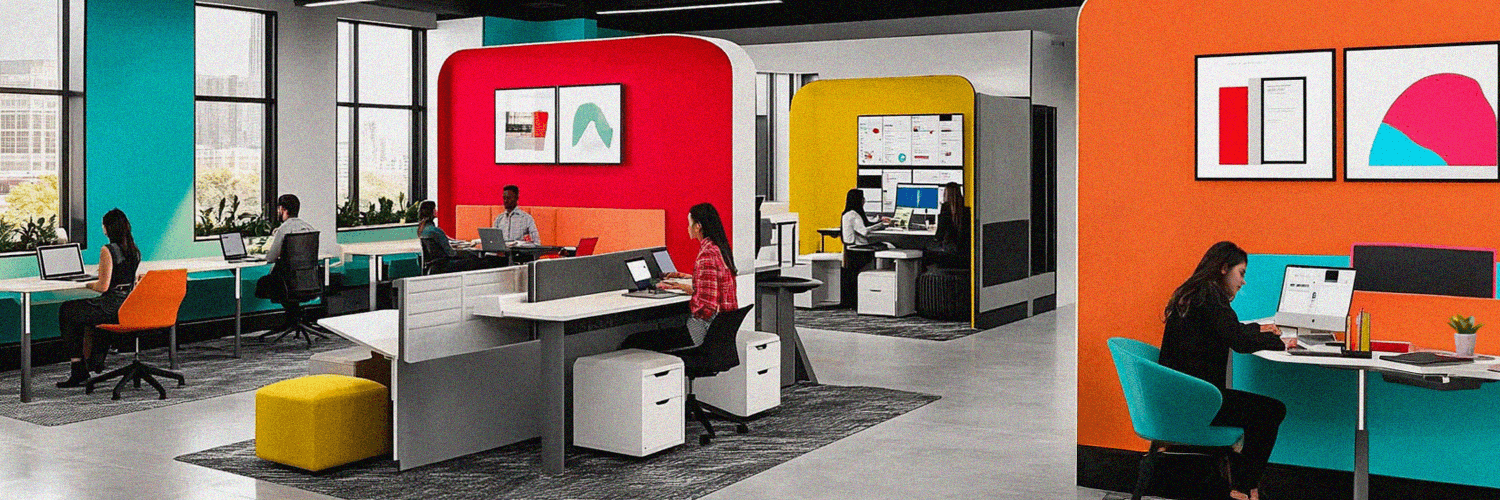There is no question that our idea of a modern workplace is evolving. With advanced technology at our fingertips and societal demand for flexibility, it only makes sense that these concepts will translate in the workplace. For this reason, companies are looking to enhance their own workplaces and get with the times. There are endless benefits to modernizing your workplace, such as increased productivity, creativity, and morale. It's safe to say that these are qualities desired by team members and management alike. We will discuss five upcoming trends that will begin to appear in the workplace of the future so that you can implement them in your own office and cultivate a modern workplace.
Social IT
Gone are the days where the typical office was a dull and monotonous environment. Today, professionals seek an uplifting and positive workplace where they feel that productivity and collaboration are cultivated. Encouraging a more flexible and social work environment can do wonders for boosting morale – and success. Providing team members with the resources to create quality work through collaboration is key to a modern workplace. A significant component of developing a social workplace is accessibility. If you consider social media, users have access to their social networks through various platforms and technologies, and the workplace can work the same way. Nearly every team member in your organization likely has a smartphone with consistent Internet access. Providing an enhanced level of access to your organization's resources and network will cultivate a more social workplace. To maximize the value that a team member can contribute at any given time is a no-brainer.
To achieve this, many organizations are utilizing collaboration platforms. Platforms such as this make it painless for team members to share information, in addition to demonstrating demos, training events, and presentations from any device. By recording workflows directly off mobile devices, you allow users to share information more efficiently, thus connecting with the workplace from anywhere. Furthermore, a collaborative platform will likely encourage team members to engage with their workplace network more. Offering the ability to seamlessly share relevant information can show team members that they are a significant part of the organization and their contributions matter. Most importantly, this is what professionals want in the modern workplace. Embracing the social IT way of interaction will create a more social and productive workplace.
Hybrid Work
To enhance collaboration and flexibility further, transitioning your workplace to hybrid work is hugely beneficial. Hybrid work allows employees to work either in-office or remotely, giving them the decision to choose their own workplace. This concept is possible through the advanced workplace technology we have today. Between virtual meetings, instant messaging, email, and software that allows for multiple users to access work simultaneously, implementing hybrid work is a breeze – you likely already have these in your office!
Hybrid work is not a new trend by any means, but it has significantly grown in popularity in the last year for obvious reasons. Whether it be for health reasons or personal preference, allowing team members the flexibility to choose their own workplace is a huge benefit. For most roles, it is not necessary for team members to be in the office every day to complete their tasks. Not only will team members be able to choose a workspace that they feel most productive in, but you will also find it easier to manage a shared and socially distanced workplace – which is a necessity in our reality. With quality technology, achieving successful hybrid work is easily attainable, and your team members will thank you for the flexibility.
Desk Booking
Another way to allow team members to choose their own workspace is through hot-desking. This is an office organization concept involving multiple team members using a single physical workstation or surface during different time periods, rather than having a singular assigned desk or office. This allows team members to use any available desk on a given day, which they can base on their activities for the day, cultivating an activity-based workplace. With this system, team members can base their work environment on their tasks. If a team member feels more productive in a quiet and private area, they can choose a more secluded workspace. Alternatively, those seeking collaboration can choose to sit in an open room with several desks nearby. This concept is believed to significantly increase productivity and morale, making team members feel as though they are in control of their environment, in addition to seeing that their company cares for their individual needs.
While hot desking is a popular and beneficial system, it can come with complications. Team members may find that their desired workplace is at capacity or take issue with the safety concerns of shared surfaces. The best way to resolve these concerns is through implementing a desk booking solution. Desk booking allows team members to book their workspace, the layout of which is uploaded to the software. Whether they book in advance or right before coming into the office, team members will be guaranteed the desk that they have booked. This solution is also great for managing safety requirements that all offices are adjusting to. With capacity control, management can ensure that the number of team members in a given space is limited so that the office is safe and distanced. If you are struggling to manage a shared office space, desk booking is the answer.
Sensors
Another upcoming workplace solution is implementing IoT sensors. With intelligent capabilities, these sensors are instrumental in managing office capacity. With motion-sensing technology, the sensors can track occupancy in a given area and collect that data. This is an excellent tool in maintaining a safe office environment and ensuring that safety protocols are being followed. Beyond capacity management, sensors can also be used to save energy in the office. With the same motion-sensing capabilities, you can add sensors to your lights around the office. As team members enter a workspace, the lights will turn on and off again once exited. This solution is great for saving energy and cost in the office while creating a more environmentally sustainable workplace.
Artificial Intelligence
Another significant component of the modern workplace is automation and AI. These capabilities will become indispensable in the near future, optimizing how companies conduct business. Many fear that human roles will become obsolete with the rise of AI, but this is not the case. AI will simply assist team members in the roles they already conduct, automating repetitive tasks and quickening time-consuming activities. Efficiency and output rates will skyrocket with the use of AI, allowing team members to focus more on the creative process than the tedious data management they may be performing manually. This technology can be used in various ways, whether optimizing the hiring process, data analysis, and predictive planning. Overall, the workplace of the future is not one to be wary of. If you embrace these modern tools, you will see instant benefits, boosting productivity and morale, translating into success. The future is now, and it’s time to get on board.











